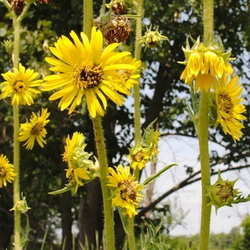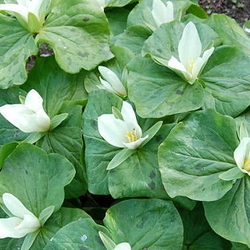(Editor's Note: This article was originally published on April 14, 2009. Your comments are welcome, but please be aware that authors of previously published articles may not be able to promptly respond to new questions or comments.)
My Aunt Bett clucked the word. She didn't say it, she clucked it. Sounded just like one of those partridges that I looked for in the old pear tree, thinking that was where it made its home. She told me it was an Indian word, and since I thought she knew everything, I believed her. Turns out, it is an Algonquian word, kinnikinnick, which means mixture.
Some of the Native Americans and the colonists dried the leaves of the plant and mixed them with tobacco. I learned about kinnikinnick from Aunt Bett, but she sure didn't tell me it could be smoked. She had already scared me enough when I caught her smoking dried mullein the time she had pneumonia. But I never did catch her smoking bearberry.
I don't remember seeing it growing in very many spots in the mountains of eastern Kentucky. It must have been there, though, because I do remember going with Aunt Bett to find it. I also remember helping her dry its leaves, so she could make a tea from them. The teas were used to treat kidney and bladder infections.
Arctostaphylos uva-ursi is a low, trailing evergreen shrub that resembles a vine. Bearberry, one of its most common names, forms a dense protective carpet over dry barrens usually, but most often we found it trailing over the cliff overhangs in the mountains. It is native to Eurasia, but is naturalized throughout North America as far south as Virginia and west to California. Its leaves are beautiful with a dark leather look. They are alternate, about an inch long, oval shaped and tapering toward the base. They have very short leafstalks. Their pinkish, whitish, waxy, urn shaped flowers are even prettier than the leaves. They bloom in spring and early summer and are followed by bright red berries that ripen in autumn and last through the winter.
The berries act as a survival food for bears, birds and other wild animals when little else is available. We only had an occasional lost bear in our mountains in southeast Kentucky, (lost because we just knew that somebody from Virginia had chased it across the mountain right into our back yard) so the berries stayed pretty intact all winter long. There must have been enough food so that nothing else went hungry. I have never known folks who thought the berries were very tasty, and I might as well admit that they are pretty mealy and tasteless on your tongue, so I have to agree with them. They sure were pretty, though.
In traditional herbal medicine it isn't the berries but the leaves that have held the highest importance. Picked in the fall, the leaves were heat dried for medicinal use. That means they were placed on a flat surface and heated in the oven of the cookstove, on a low heat for several hours. That seemed to get the moisture out of the leaves a little more quickly than the unstable heat of the mountain sunshine. An infusion was made from the leaves, which folk healers have used for centuries as a tonic and diuretic in many parts of the world. Some tribes of Native Americans drank the tea for back sprains and muscle aches. Bearberry leaves contain arbutin, a powerful astringent that is thought to have an antiseptic effect on the urinary tract and that may account for bearberry's reputed effectiveness in treating kidney and bladder infections. The leaves are also rich in tannins, which the Native Americans used for tanning leather.
The plant is rare or protected in some states. I have not seen it here in Kentucky for a long time, but it could be that I have not looked in the right places. Pharmacologists suggest that the plant may have urinary antiseptic properties, but its reported diuretic effects are questionable, which means it is not used in any medicinal preparations. It doesn't seem to be used by many herbalists either. I wonder what happens to plants like that. It is such a beautiful winter plant with its plush green leaves, growing low to the ground, full of bright red berries; and it is pretty in spring with its clusters of little rounded pink blooms. I don't think the wildlife would have destroyed it. And I doubt that it was ever overly used for medicinal purposes. I do know that it is a plant highly valued for its use in preventing erosion. So tell me where it is hiding, and why I am having so much trouble finding it.
When I remember plants that I knew years ago, I become a little obsessed with them. It is like remembering an old friend you haven't heard from, and you wonder what happened. I was crazy about bearberry's name, the one I knew it by when I was little: ka-nik ka-nik, ka-nik ka-nik, but I haven't even heard that word in such a long time. Maybe if I could get out and roam around in the mountains calling its name sometime this spring, I might be able to find it. Or maybe I would find a partridge in a pear tree calling back to me.
Ka-nik ka-nik, ka-nik, ka-nik.
Photos from this article are from PlantFiles, thanks to these photographers: DaylilySLP, RosemaryA, and Kennedyh.
Verification of information comes from various wildflower books in my collection.
















